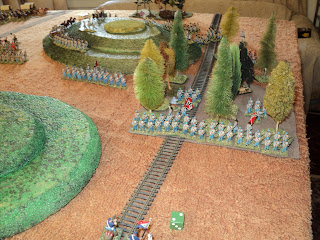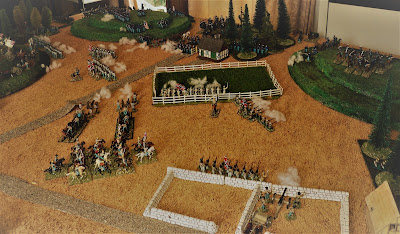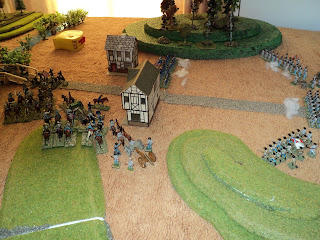 |
| Leading elements of Trimble's Brigade come to the aid of the Stonewall Brigade. |
As General 'Stonewall' Jackson's Army surged onto the field like an incoming wave, the preliminaries were over, and the stage set for a major action. The previous evening's combat, the early morning pursuit, and the clash between the 'Stonewall' Brigade and Col Knipe's column - these were but skirmishes compared with what was to come. For, marching up behind his little force, Colonel Knipe knew, General Shields's whole command would soon be with him.
 |
| The Army of the Valley having broken off its pursuit of General Banks, retraces its steps to aid General Winder. |
The Confederate Army of the Valley comprised:
Commander: Major-General Thos. J. (Stonewall) Jackson
Jackson's Division:
Winder's (Stonewall) Brigade:
5, 27, 33 Va - somewhat reduced in numbers from the 73 figures with which they began the morning;
Poague's and Cutshaw's batteries attached
Taliaferro's Brigade:
10 Va (27 figures); 23 Va (27); 37 Va (26) - Total 80 figures
Ewell's Division:
Trimble's Brigade:
15 Ala (26), 21 Ga (26), 21 N.C. (21) - Total 73 figures
Raines's Battery (4 figures, 1 gun)
Taylor's Brigade:
La Tigers (18), 6 La(25), 7 La(22) - Total 65 figures
Lusk's Battery (4 figures, 1 gun)
Cavalry:
2 Va Cav (Munford, 21 figures), 7 Va Cav (Ashby, 20 figures)
Chew's Flying Artillery (4 figures, 1 gun)
Overall strength: 352 figures (less Winder's losses), 5 guns (3 S/B, 2 rifled)
 |
| Kimball's Brigade, of General Shields's Union Division, arrives from Front Royal |
 |
| Tyler's Brigade enters the fight, covered by 1st Maine Cavalry. |
Now, the arrival of these troops was programmed by sector, north (near the Manassas Gap Railway), centre (close by the Front Royal road), and south (near Turvey's shack and walled fields). Where each brigade and cavalry regiment arrived was determined by a die roll. Further, just 6 units - regiments, battalions or batteries - would be arriving in any one turn. The result was that Trimble's Brigade, including its attached artillery, arrived behind it's lead regiment (15th Alabama) in the centre, along with Ashby's cavalry and Chew's battery. Taliaferro's Brigade, followed by Taylor's, came in on the northern flank. This tended to nudge the Stonewall brigade towards the right - the southern - wing, where they were joined by Munford's cavalry.
General Jackson's orders were simple: advance, and drive back or destroy any enemy encountered. The fact was, his situation was not a comfortable one, for it was beyond the ridges in front of him that his line of communication lay. That line had to be cleared before the end of the day, and already the sun was nearing its zenith.
 |
| Kimball's Brigade shaking out into line formations about Barnett's barn. |
The Confederates were still pouring onto the field when the first elements of Shields's column arrived, and General Shields himself took over command of the battlefield. Colonel Knipe had begun the day with 73 figures of all arms, and a rifled battery (1 gun). To these Shields added:
Shields's Division:
Kimball's Brigade:
14 Indiana (27), 4 Ohio (27), 8 Ohio (27), 7 W. Va (27)
Tyler's Brigade:
5 Ohio (27), 7 Ohio (27), 29 Ohio (27), 66 Ohio (27)
Cavalry:
1 Rhode Island Cav (15); 1 W. Va Cav (15)
Artillery:
H/1 Ohio Artillery (4); L/1 Ohio Artillery (4), I/1 New York Artillery (4).
Overall strength (not counting Knipe's column): 258 figures, 3 guns.
Including Knipe's command at the beginning of the day raises the numbers to 331 and 4 guns. Fewer than the Confederates, it's true, but all units began the day fresh. (There were 683 figures, plus 8 formation commanders, altogether - a fairish number to field on a 6ft x 4ft table, eh?)
 |
| The approaching clash... |
Just as the Confederates had been, the Union forces were in turn subjected to programming where they arrived: north, centre or south, and a maximum of 6 units the turn. Wouldn't you know it, they practically mirrored their opponents. Kimball's Brigade arrived in the centre and Tyler's on their right. First West Virginia Cavalry came up behind Kimball, along with two of the gun batteries. Only 1st Rhode Island Cavalry and a battery of Napoleon guns seized the ridge beyond the woods south of Barnett's barn.
 |
| 10th and 23rd Virginia lining Railroad Wood. Both have kept back a proportion of their numbers to 'fit' onto the available frontage. |
Beginning with the first clashes in the centre, a dogged firefight rippled along the front northwards as the action became more general. Soon both sides were tearing great gouges in each other's lines. In the railroad wood, 23rs and 10th Virginia found the front too narrow to deploy their full strengths, and both held back a quarter in reserve. Things didn't go well to begin their duel against the Ohioans who came up against them, neither. Despite their cover, the Confederates got the worse of the initial encounter. Tenth Virginia fell back into the woods, leaving the 23rd to sustain the fight unaided. It took over an hour to persuade the 10th to return to the fight.
 |
| The view eastwards from behind Talliaferro's Brigade. The Louisiana Tigers in support of the Virginians in the forest. |
Thirty-seventh Virginia soon also found the action too warm for their comfort, and drew back, though in better order than the 10th. Surging up behind them, the Louisiana Brigade quickly took up the quarrel. There was to be no respite for the Federals.
 |
| Warm work: a savage firefight all along the line. |
Throughout the sustained musketry, the Confederates continued to try to press forward, but against the gallingly accurate fire from the Union infantry, it was tough going. The Confederate left and centre had no decisive edge in numbers, and it was not clear who was getting the better of the punishing exchanges of musketry and gunfire. Third Wisconsin, of Knipe's command, broke and ran before they could be properly supported by Kimball's Brigade, but that scarcely made any difference.
 |
| 6th and 7th Louisiana swarm over the hill to support Taliaferro and Trimble. |
 |
| What is happening on the Confederate right? The Union positions seems to be thinly held: One cavalry battalion and one battery... |
Whilst that mutual hammering went on, the Confederate commander turned his attention to the more sparsely populated, and so far quiescent, southern flank. Could something decisive be achieved there?
To be continued...


























